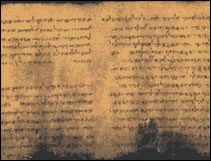
Process of copying the Old Testament by Jewish Scribes
Scott Manning
March 17, 2007
|
Discuss this article in our forums.
 In 586 B.C., Jerusalem was captured by the Babylonians. The Temple was looted and then destroyed by fire. The Jews were exiled. In 586 B.C., Jerusalem was captured by the Babylonians. The Temple was looted and then destroyed by fire. The Jews were exiled.
About 70 years later, the Jewish captives returned to Jerusalem from Babylon. According to the Bible, Ezra recovered a copy of the Torah (Genesis, Exodus, Leviticus, Numbers, and Deuteronomy) and read it aloud to the whole nation.
From then on, the Jewish scribes solidified the following process for creating copies of the Torah and eventually other books in the Old Testament.
- They could only use clean animal skins, both to write on, and even to bind manuscripts.
- Each column of writing could have no less than forty-eight, and no more than sixty lines.
- The ink must be black, and of a special recipe.
- They must verbalize each word aloud while they were writing.
- They must wipe the pen and wash their entire bodies before writing the word "Jehovah," every time they wrote it.
- There must be a review within thirty days, and if as many as three pages required corrections, the entire manuscript had to be redone.
- The letters, words, and paragraphs had to be counted, and the document became invalid if two letters touched each other. The middle paragraph, word and letter must correspond to those of the original document.
- The documents could be stored only in sacred places (synagogues, etc).
- As no document containing God's Word could be destroyed, they were stored, or buried, in a genizah - a Hebrew term meaning "hiding place." These were usually kept in a synagogue or sometimes in a Jewish cemetery.
The final item is why we have no original manuscripts of the Old Testament today.
After Jerusalem was sacked by Rome in the First Century, the process was lost. While a Hebrew version of the Old Testament continued to exist, the language wasn't spoken by many. Greek and eventually Latin versions continued to be copied.
How Accurate Were the Scribes?

Beginning in the Sixth Century and into the Tenth Century A.D., some European Jewish scribes continued a similar method for copying manuscripts of the Old Testament in the original Hebrew language as originated by the scribes before Christ.
Until 1948, the oldest manuscripts of the Old Testament dated back to 895 A.D. In 1947, a shepard boy discovered some scrolls inside a cave West of the Dead Sea. These manuscripts dated between 100 B.C. and 100 A.D. Over the next decade, more scrolls were found in caves and the discovery became known as the Dead Sea Scrolls. Every book in the Old Testament was represented in this discovery except Esther. Numerous copies of each book was discovered (For example, 25 copies of Deuteronomy).
While there are other items found among the Dead Sea Scrolls not currently in the Old Testament, the OT items that were found have few discrepancies to the versions from the Tenth Century. While not perfect, this is our best measuring stick to how accurate the Jewish scribes were throughout the centuries.
References

Comfort, Philip Wesley (1991). The complete guide to Bible versions . Wheaton, IL: Tyndale House Publishers. pp. 16-20. . Wheaton, IL: Tyndale House Publishers. pp. 16-20.
Connolly, W. Kenneth (1996). The indestructible book: the Bible, its translators, and their sacrifices . Grand Rapids, MI: Baker Books. pp. 17-18. . Grand Rapids, MI: Baker Books. pp. 17-18.
Discuss this article in our forums

Got something to say on this topic? Tell us about it in our forums.
|
